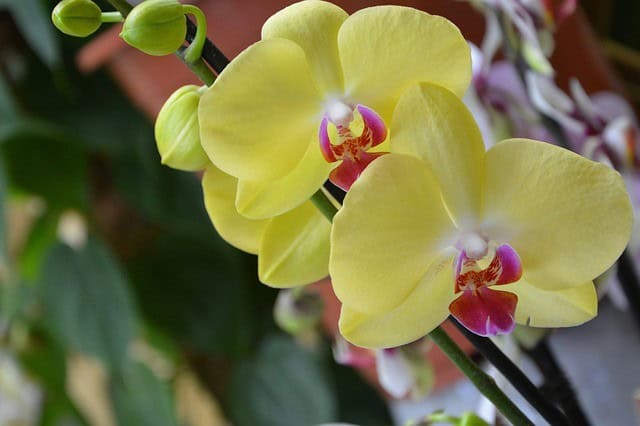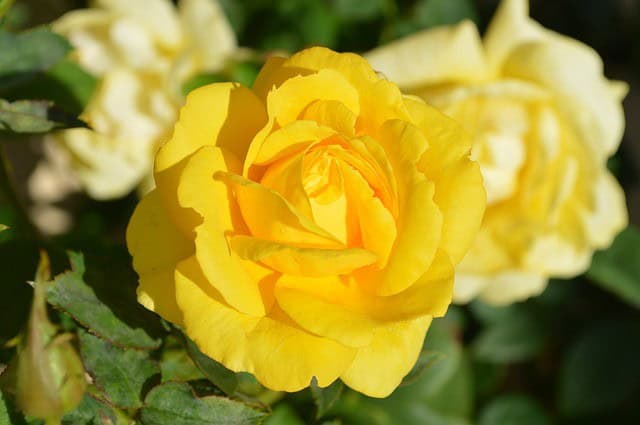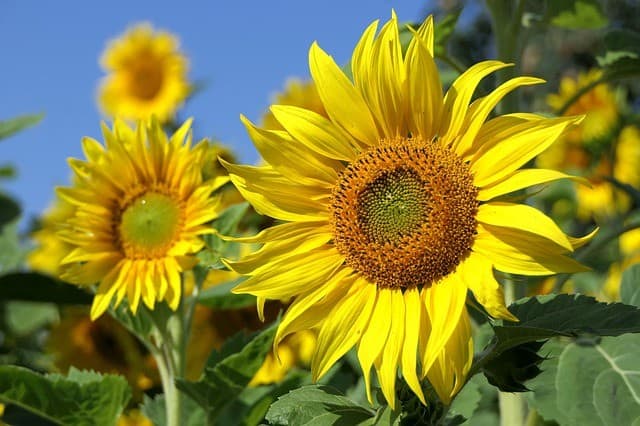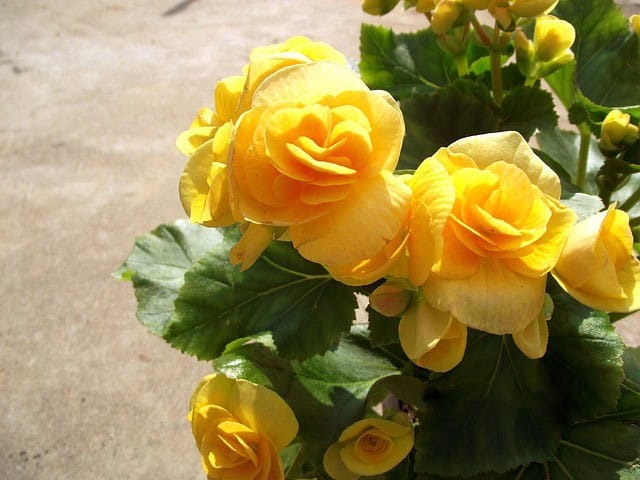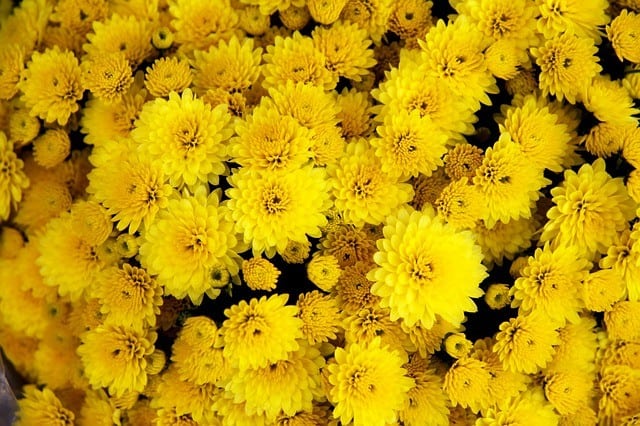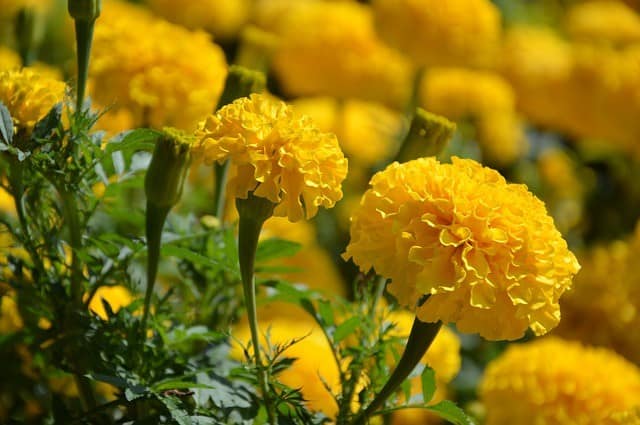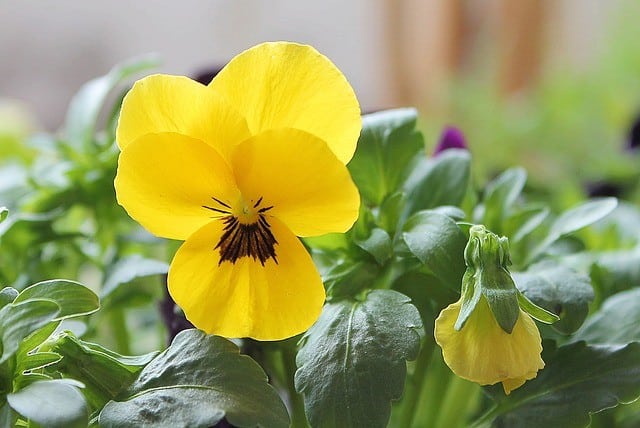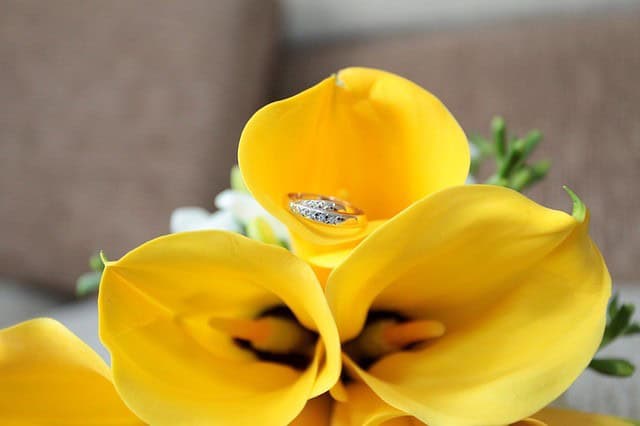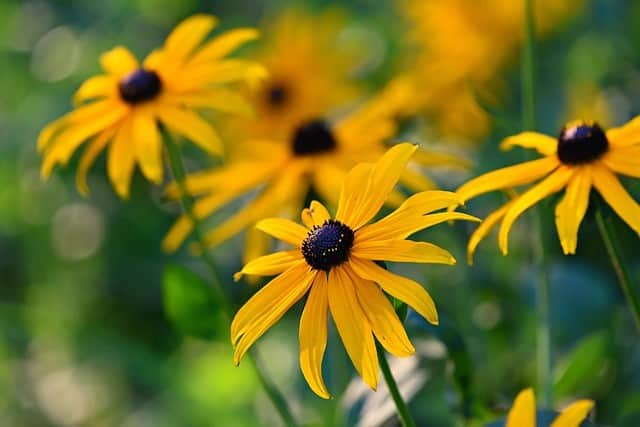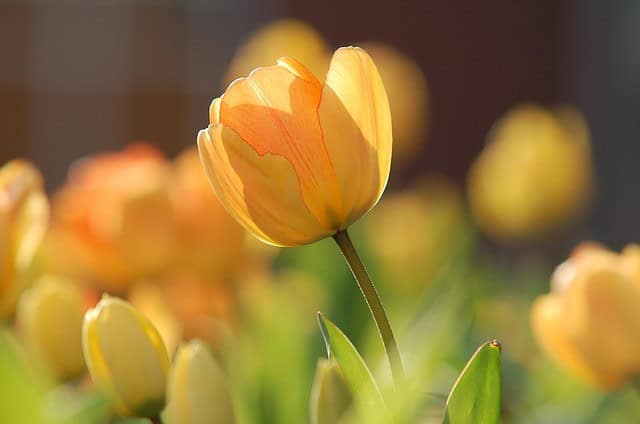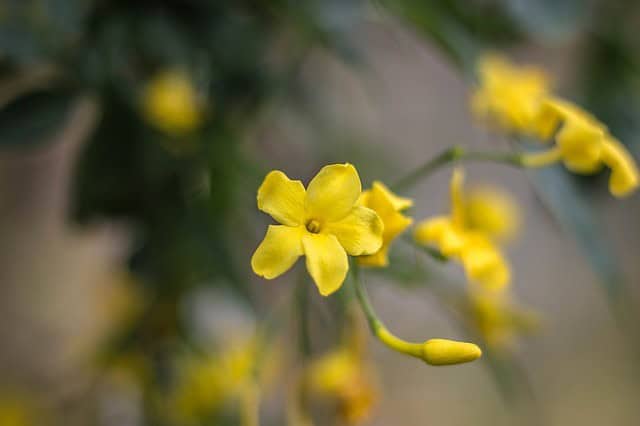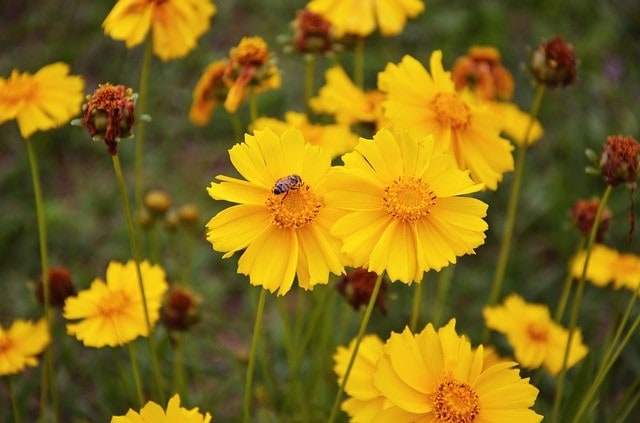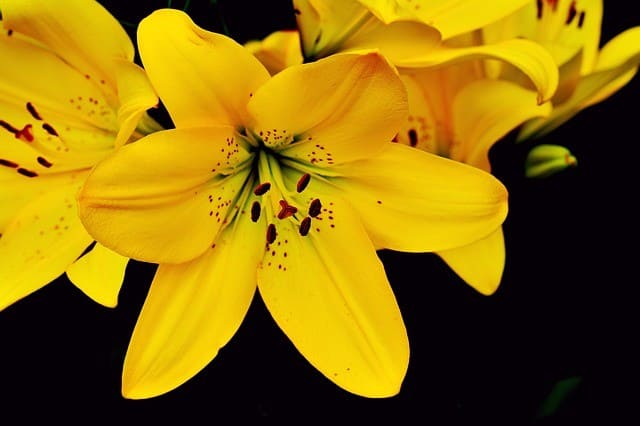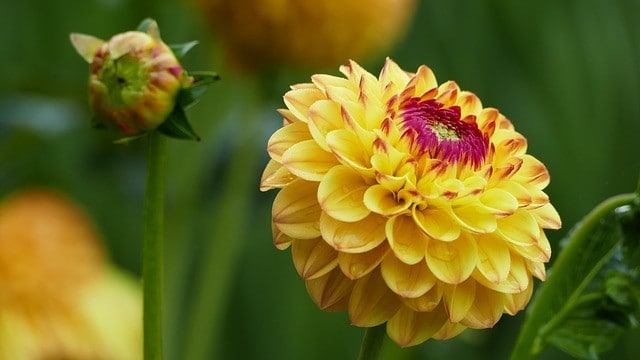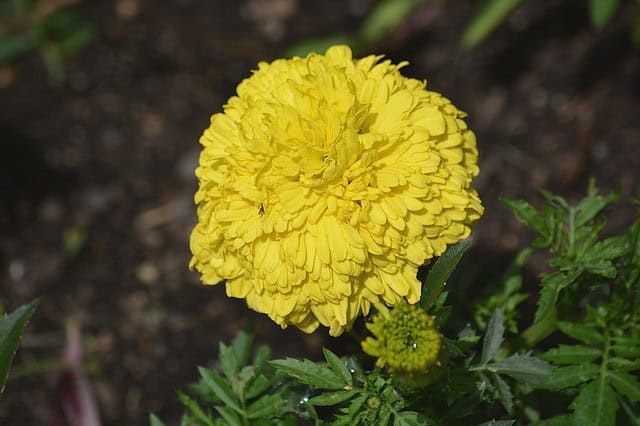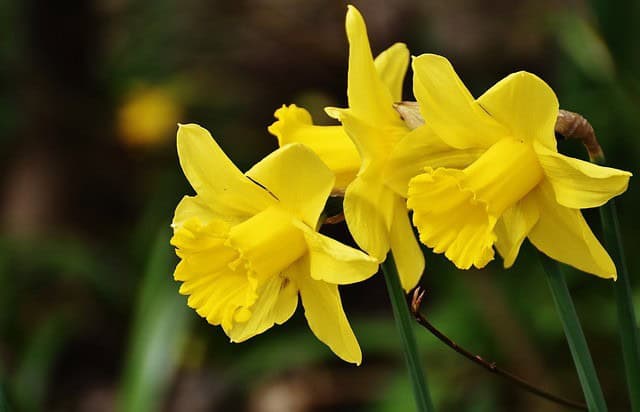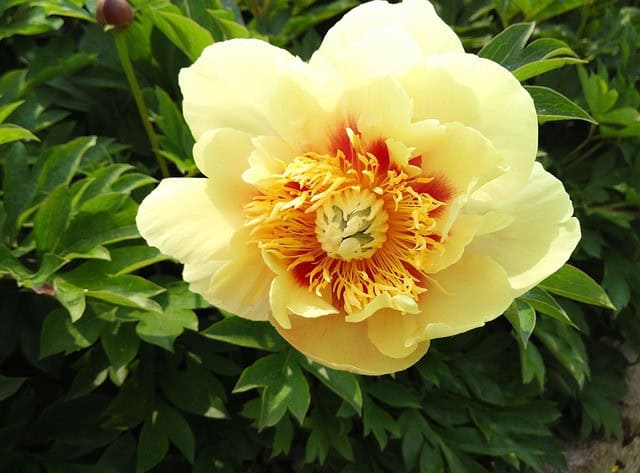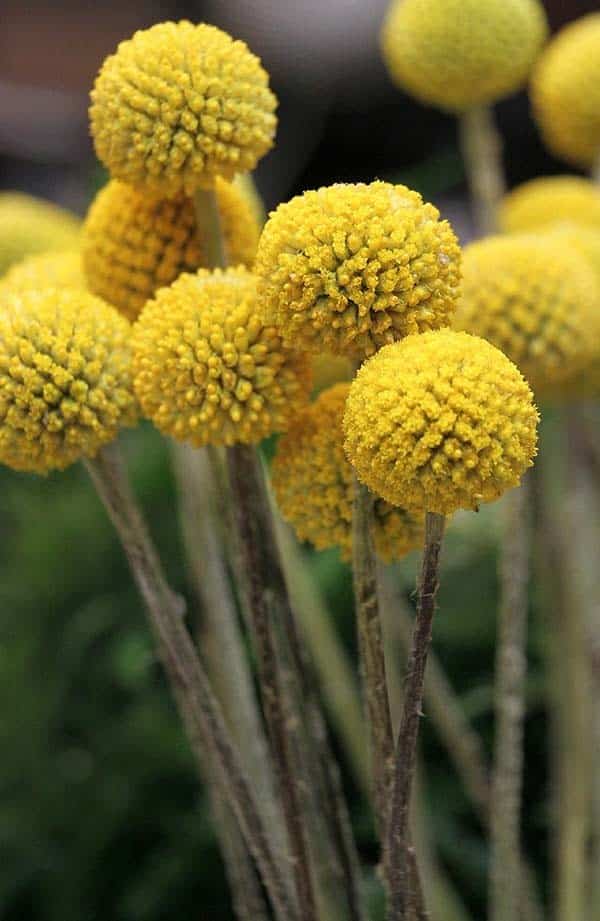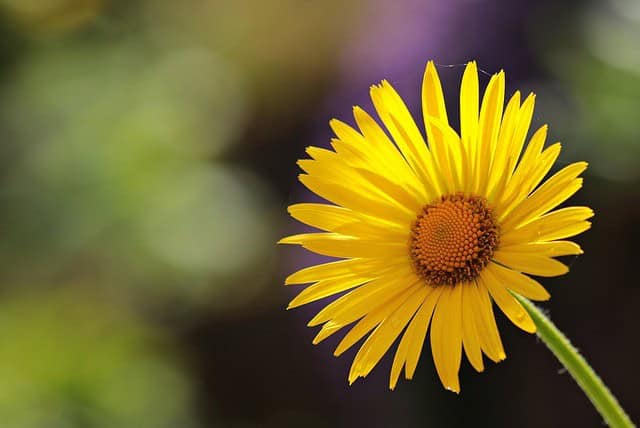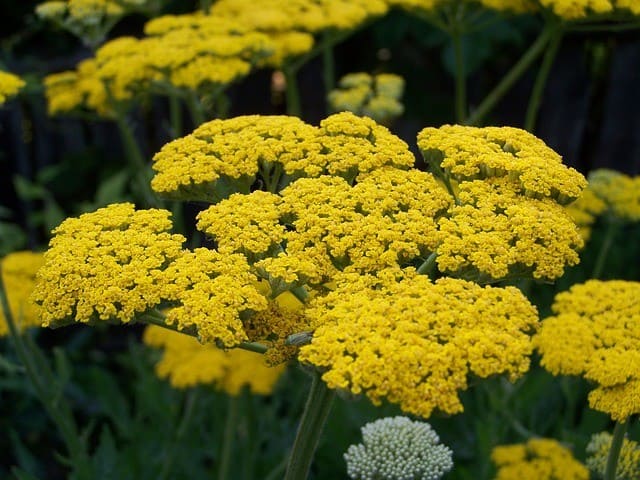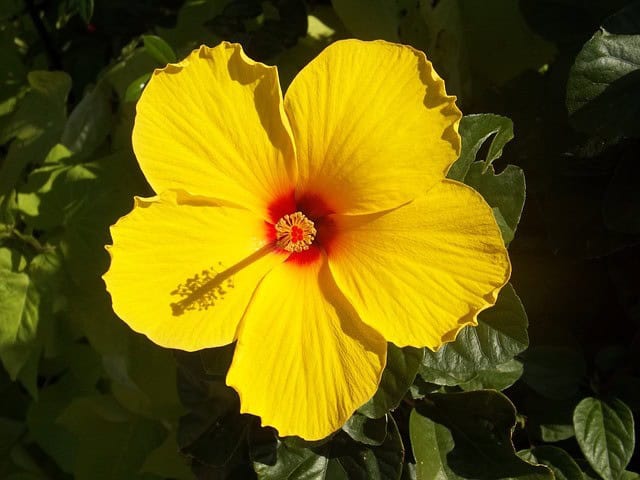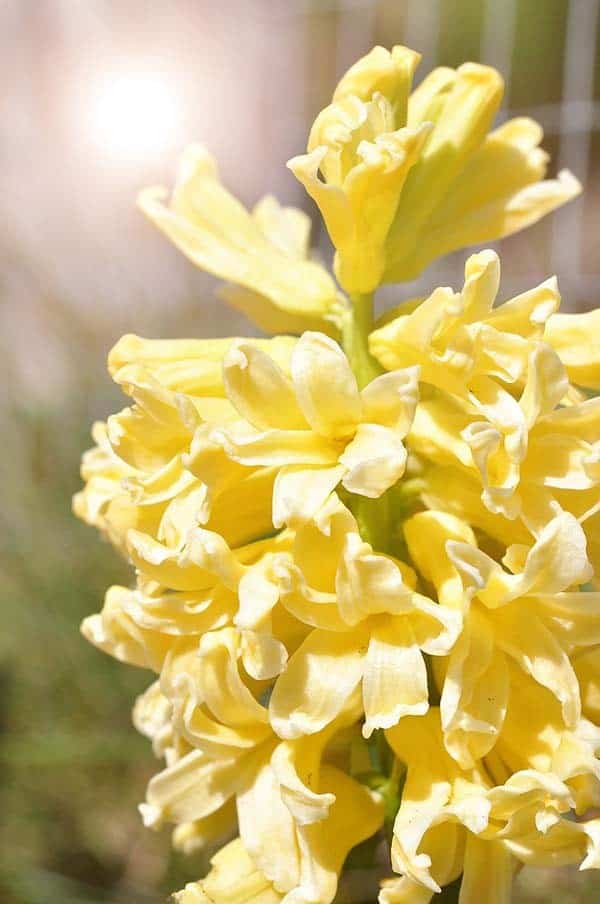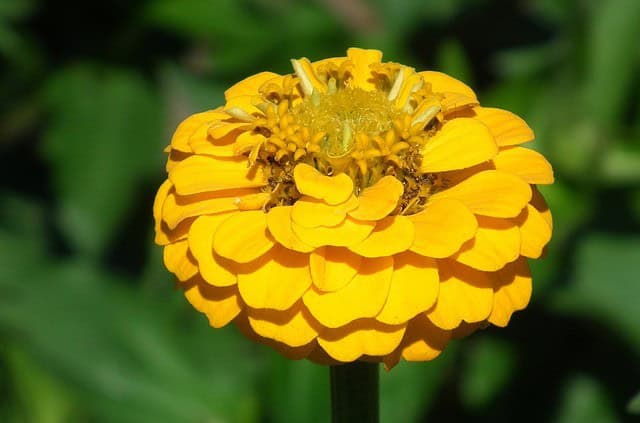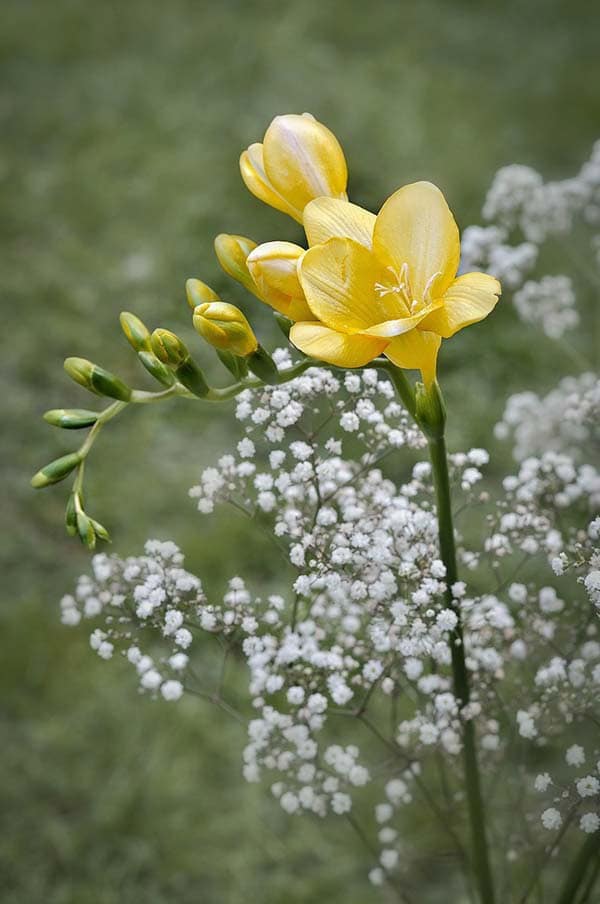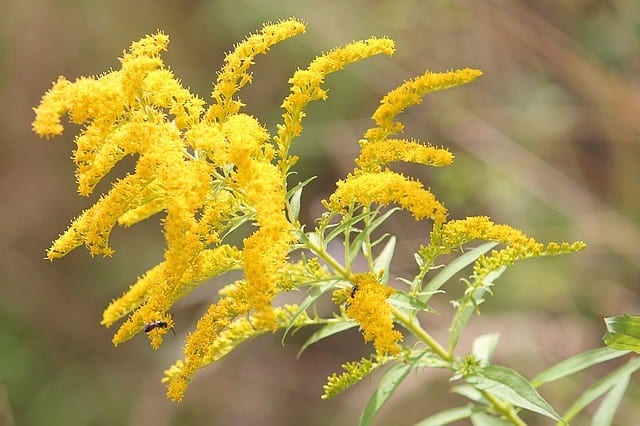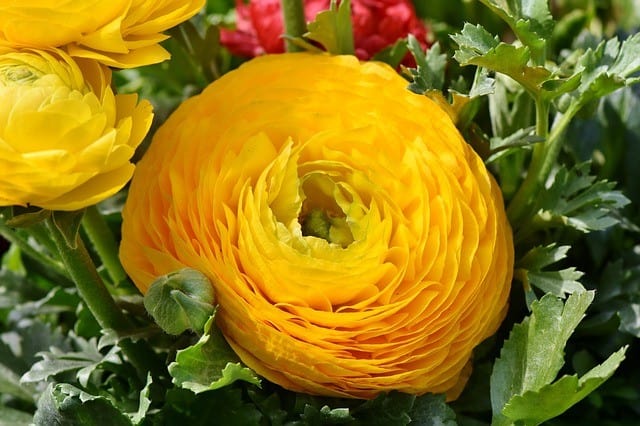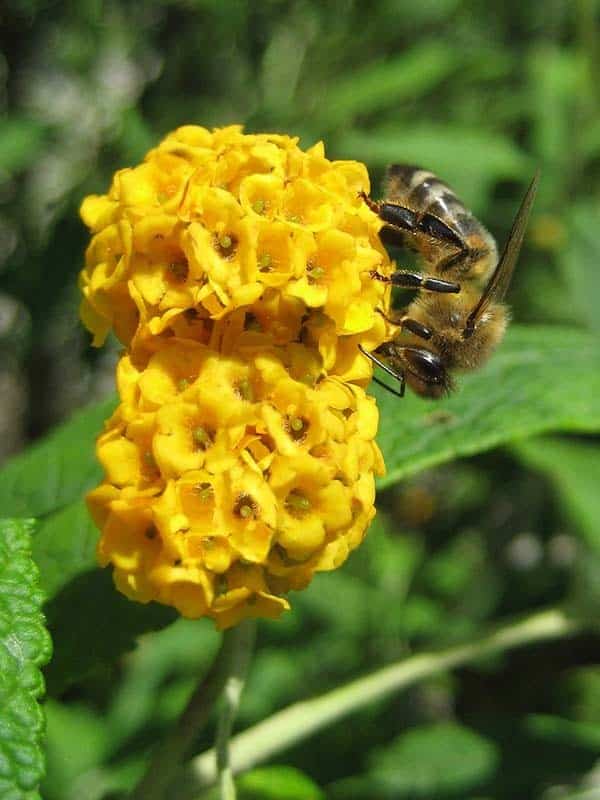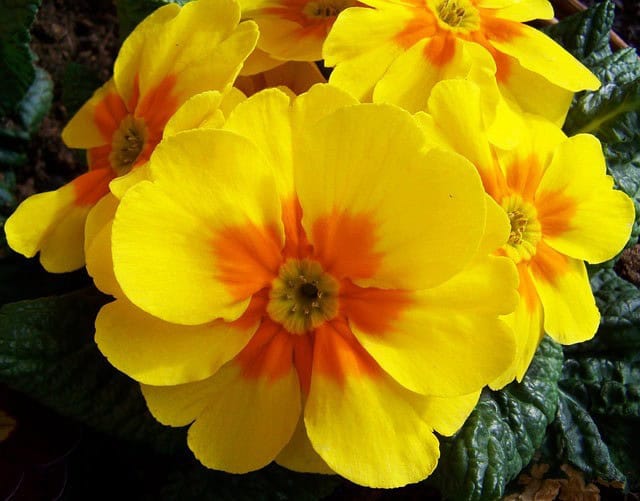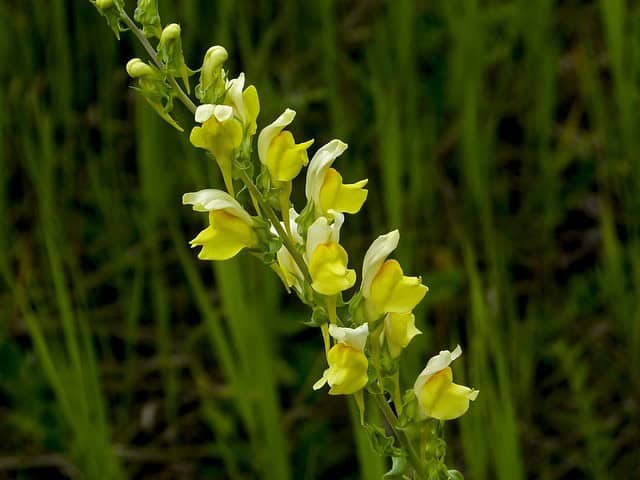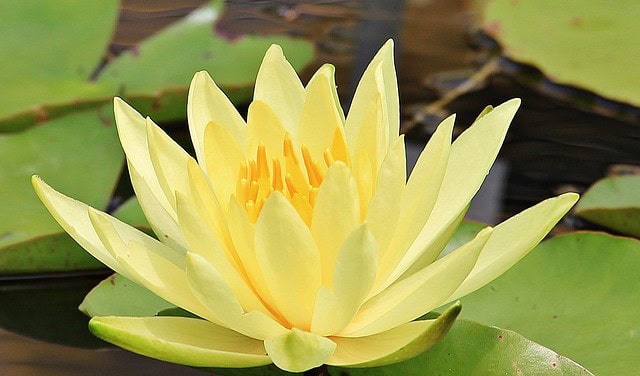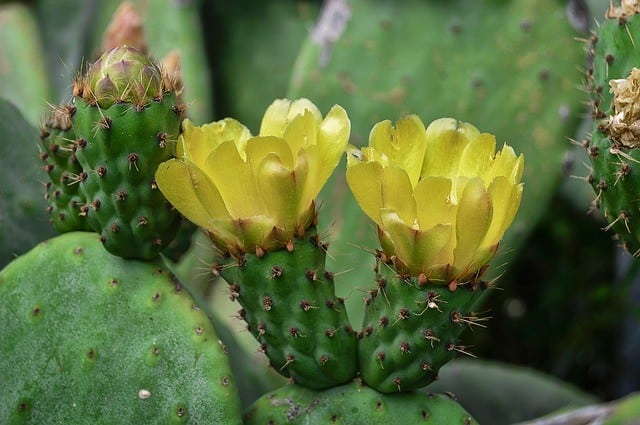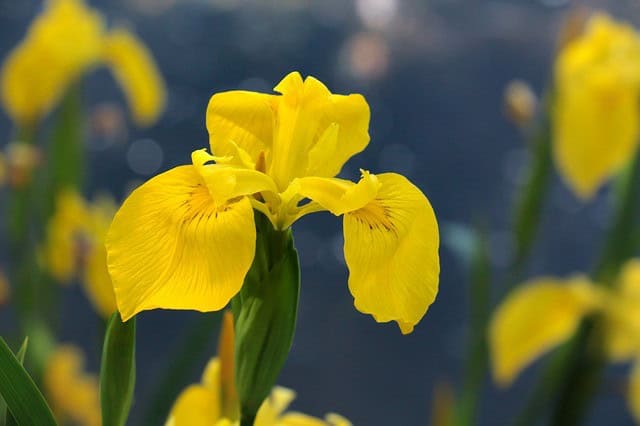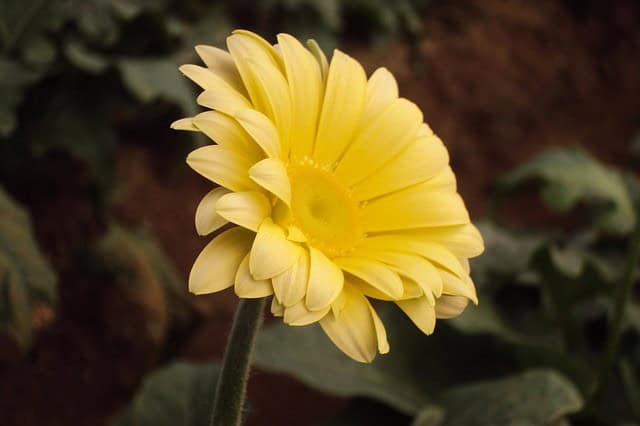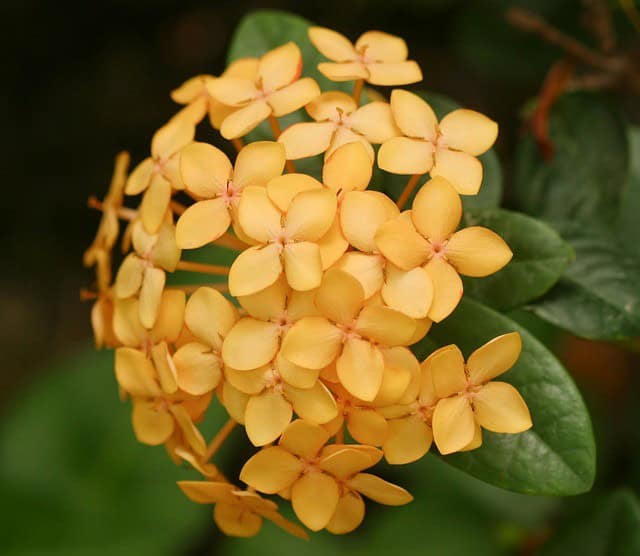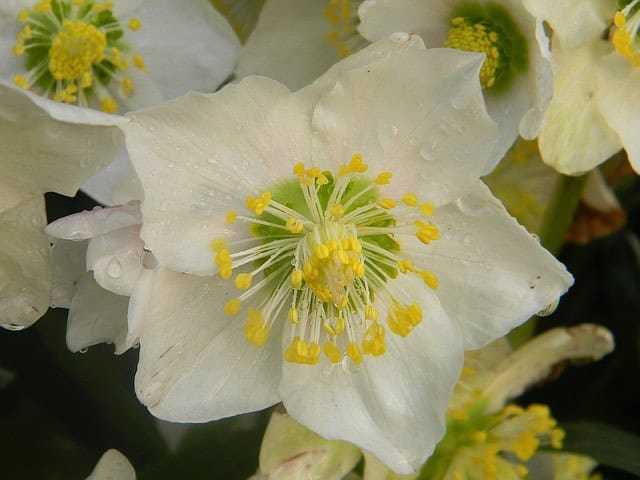Elevate the ambiance of your garden by incorporating a splash of sunshine! Are you seeking to create a warm and inviting outdoor space? If so, why not consider introducing some of the numerous types of yellow flowers that can brighten up your garden. We’ve curated a comprehensive list featuring over 35 stunning varieties, each accompanied by vital growing insights such as sun and soil requirements.
Discover which of these vibrant flowering plants will perfectly complement your garden’s unique character.
Yellow Rose
The list begins with the radiant queen of yellow flowers – the yellow rose. These vibrant blooms, often referred to as a symbol of good cheer, are guaranteed to bring a burst of sunshine into your day, even on cloudy or rainy days. However, it’s essential to note that they require at least 5 hours of direct sunlight daily, which is true for most rose varieties.
With the right conditions, you can expect these stunning flowers to thrive in USDA zones 2 to 11, blooming from late spring to early fall. They prefer full sun and well-drained soil, growing up to 10 feet tall as a perennial.
Sunflower
The sunflower’s unique charm lies in its striking appearance, featuring a brown center filled with seeds and a large, daisy-like flower face. This vibrant bloom is often used in wedding arrangements during the fall season, adding warmth and energy to any setting. While it may not have a strong scent, its cheerful presence can still brighten up your yard. Interestingly, sunflowers are known for their resilience, but be mindful of over-fertilization when cultivating them.
With USDA growing zones ranging from 3 to 10, this perennial flower thrives in well-drained soil and full sunlight, reaching heights of 1-3 feet during early summer to early fall. Its adaptability makes it a popular choice for many gardeners.
Begonia
When it comes to the meaning behind different types of yellow flowers, one fascinating example is the Begonia. This beautiful bloom can be used as a thoughtful gift to express gratitude towards someone special, and its symbolism extends to peace, harmonious communication, and justice. What makes the Begonia truly unforgettable is its unique petals with a buttery yellow color and rich texture.
While it thrives in well-drained soil, it’s essential to strike a balance between moisture levels, avoiding overwatering. For optimal growth, Begonias prefer USDA Growing Zones 8-10, blooming from late spring to early fall under full sun to partial shade conditions. At 0.5 to 1.5 feet in height, this perennial plant is perfect for container gardens.
Chrysanthemum
There are over 40 wild species of Chrysanthemum, making it a beloved and widespread type of tropical flower. Its versatility is evident in the numerous shapes and sizes it comes in. But did you know that its meaning can vary depending on the color? For instance, red Chrysanthemums symbolize long life, love, and deep passion, while yellow ones represent sorrow and neglected love.
Despite the differences in meaning, this perennial flower is a popular choice for many gardeners.
With proper care, it can thrive in USDA zones 3 to 9, blooming from mid-summer to late fall. It prefers full sun to partial shade and well-drained soil. When grown to its full potential, Chrysanthemum can reach heights of 1 to 3 feet.
Tip: Don’t forget to read about pinching, a crucial technique for growing healthy and thriving Chrysanthemums.
Marigold
Marigold, an annual yellow flower, is a stunning addition to any garden. While its scent may not be everyone’s cup of tea – think peppery notes – its blooms will keep your outdoor space looking vibrant all summer long. In fact, this hardy flower can thrive in the hot summer sun, providing a pop of color even on the most sweltering days. To ensure your Marigold flourishes, remember to let the soil dry out slightly before rewatering and provide plenty of direct sunlight.
With proper care, these flowers will grow up to 1.3 feet tall, adding a playful touch to your garden. Interestingly, Marigold is considered a perennial in USDA Growing Zones 2-10, blooming from early summer to mid-fall. Its ideal growing conditions include full sun and well-drained soil.
Yellow Pansy
Pansies, with their bright yellow petals and charming demeanor, have earned a special place in many gardeners’ hearts. Not only do they thrive in creating picturesque borders and ground covers, but they’re also adaptable and fragrant, making them a delightful addition to any outdoor space.
Beyond their aesthetic appeal, Pansies hold significant symbolic value.
The free-spirited Viola Wittrockiana is often associated with loving thoughts, remembrance, and the warmth of human connection – particularly when it comes to expressing affection between two people.
When cultivating these lovely flowers, be sure to keep them well-watered, as drought can be a major threat to their survival. With proper care, you can enjoy Pansies’ vibrant blooms in your garden during the spring season.
If you’re considering bringing Pansies into your garden, here are some key details to keep in mind:
* USDA Growing Zones: 2-11
* Blooms In: Spring
* Sun Exposure: Full Sun – Partial Shade
* Soil Needs: Well Drained
* Height: 1-3 feet
* Perennial: Yes
Yellow Calla Lily
Calla lilies, originating from South Africa, are renowned for their effortless cultivation as perennial bouquets. Their striking arrowhead-shaped foliage adds an air of sophistication and elegance to any setting. One of the most notable advantages of calla lilies is their rapid flowering process, which can be expected within 5-8 weeks after planting. The ideal time to plant them is between February and June, allowing for a bountiful bloom throughout the spring and early fall seasons.
When caring for these lovely flowers, it’s essential to strike a balance when watering, as they thrive in well-draining soil and can be susceptible to root rot if the soil becomes too soggy. Additionally, direct sunlight should be avoided, with full sun to partial shade being the preferred conditions. For optimal growing conditions, calla lilies require USDA Growing Zones 2-10. They are perennials that can grow up to 6 feet in height, making them a stunning addition to any garden or arrangement.
Black-Eyed Susan
Looking for a low-maintenance, cheerful addition to your garden? Consider planting Black-Eyed Susans! These bright yellow flowers require minimal care and can thrive amidst annuals and shrubs. With a blooming period that spans from late summer to mid-fall, they’re sure to bring a pop of color to your outdoor space. To get the best out of these daisy-like blooms, be sure to leave sufficient spacing between plants and water at soil level rather than overhead.
Perfect for gardeners in USDA zones 3-9, Black-Eyed Susans are well-suited to full sun and well-drained soil. As perennials, they’ll return year after year, growing to heights of 1-3 feet.
Yellow Tulip
Tulips, with their bright yellow hues, have the remarkable ability to draw in tiny birds and stunning butterflies to your garden’s vibrant landscape. As a popular choice for autumn planting, the ideal time frame varies depending on your location – September and October are prime times in the northern regions, while the southern areas enjoy optimal conditions during October and November.
Over the years, the symbolism behind tulips has evolved significantly; what once represented hopeless love now serves as a beacon of sunshine and positivity. When cultivating these beautiful blooms, it’s essential to avoid overwatering, as they thrive in well-drained soil. For best results, plant them in areas that receive full sun or partial shade.
With USDA Growing Zones 4 to 8 and a perennial nature, tulips are an excellent addition to any spring garden, blooming beautifully under the warm sun’s rays. They require minimal maintenance and can grow up to 0.5-2.5 feet tall, making them a low-maintenance yet high-reward choice for any gardener.
Yellow Jasmine
The yellow variety of jasmine boasts a captivating and fragrant bloom, rivaling its other colors. Its name, which translates to ‘a fragrant oil from Persia’, aptly describes the flower’s intoxicating aroma. This stunning bloom unfurls from early April until mid-May, making it an ideal addition for any garden seeking a unique touch. Notably, while jasmine is renowned for its beauty, it also holds a dark secret: it is one of the most poisonous yellow flowers on Earth.
In the event of poisoning, the victim’s body becomes fully paralyzed yet remains conscious with eyes open, underscoring the importance of handling this plant with caution. When grown in USDA zones 8 to 10 and provided with full sun exposure, well-drained soil, and a height range of 5-15 feet, jasmine thrives as a perennial.
Coreopsis
Coreopsis, also known as Tickseed, is a striking perennial that boasts clump-forming, tall yellow daisy-like blooms. The abundance of delicate flowers will undoubtedly make your garden stand out from the rest! These sun-loving plants thrive in full sun, although they can also tolerate partial shade. A clever trick to keep them blooming all season long is to deadhead the spent flowers regularly. This simple technique will reward you with a prolonged display of color in your garden.
Coreopsis grows well in USDA zones 3 through 9 and produces blooms late summer into mid-fall. It requires full sun to partial shade, as well as well-drained soil. The plants themselves reach heights of 1 to 3 feet, making them an excellent choice for adding visual interest to borders or containers without overwhelming the space.
Yellow Lily
If you’re looking for a pop of sunshine in your garden, yellow lilies are an excellent choice! With their varied shapes and sizes, these vibrant blooms are sure to add some joviality to your outdoor space. Not only do they brighten up the day, but they also never go dormant, making them a lovely addition to any garden bed or shrub border.
As with other types of lilies, yellow lilies don’t require frequent watering, but it’s essential to provide deep hydration that reaches the bulb.
Additionally, avoid using strong high-nitrogen fertilizers when cultivating these beautiful flowers.
Some key details about growing yellow lilies include: USDA Growing Zones 4-8, Blooms In Spring-Early Fall, Sun Exposure Full Sun, Soil Needs Well Drained, Height 2-6 feet, and Perennial Yes.
Yellow Dahlia
The Yellow Dahlia, often referred to as the ‘Yellow star’, boasts an unmistakable characteristic – its large, buttery yellow blossoms. Interestingly, this dahlia species shares a group with cacti that feature yellow flowers, showcasing the plant’s unique characteristics. To thrive, these plants require direct sunlight and light shade during the hot summer months, allowing them to flourish. The blooms typically begin in mid-July and continue until frost sets in.
As beautiful when displayed in a vase as it is planted around the house, this perennial offers versatility and charm. A fun fact about dahlia flowers and tubers is that both are edible – the tubers have a taste similar to a radish-potato hybrid.
In terms of growing conditions, the Yellow Dahlia prefers USDA Growing Zones 8-10, blooms in mid-summer through early fall, and requires full sun with well-drained soil. Its height ranges from 2.5 to 5.
5 feet, making it a striking addition to any garden or arrangement.
Yellow Carnation
The yellow carnation, a popular annual flower, boasts a unique characteristic – each color variant holds a distinct meaning. While the symbolism may vary, the underlying message is one of significance. For instance, the yellow carnation signifies disappointment, whereas its pink counterpart represents ‘mother’s love’. Meanwhile, the red variety embodies admiration. According to Christian lore, these flowers first sprouted from the earth as Jesus bore the Cross.
It is said that the Virgin Mary’s tears fell upon the soil, giving rise to the carnations. When cultivating these blooms, it is essential to maintain a consistently moist soil environment and shield the foliage from direct heat. However, the plants do require several hours of full sun exposure each day. The USDA Growing Zones for yellow carnations range from 3 to 8, with blooming periods spanning early spring to late summer. They thrive in well-drained soils and can grow up to 1.
5-2 feet in height, making them a perennial addition to any garden.
Yellow Daffodil
Daffodils, with their trumpet-like appearance, may seem like a humorous addition to your garden or home. However, these bright yellow blooms serve as a telling sign that spring has finally arrived. One of their most charming qualities is their ability to thrive in both indoor and outdoor environments. When it comes to sharing space with pets, caution is advised, as Daffodils are toxic to animals.
On the other hand, they make an excellent choice for rustic weddings due to their unassuming yet elegant nature.
When planting, be sure to select fresh bulbs and plant them at a depth three times greater than the bulb’s height to prevent the stems from curving after blooming. USDA Growing Zones: 3-9, Blooms In: Spring, Sun Exposure: Full Sun, Soil Needs: Well Drained, Height: 0.25-2 feet, Perennial: Yes.
Yellow Peonies
Yellow Peonies, also known as Goldilocks, are a symbol of romance, prosperity, and good fortune. Their large, rounded blooms exude warmth and are often seen as an omen of peaceful marriage. These unique, slightly fragrant flowers typically begin blooming in early April and continue until late June, with the duration potentially longer in colder climates. When cultivating Yellow Peonies, it’s essential to ensure the soil drains well, as standing water can be detrimental to their survival.
In terms of growing conditions, these perennials thrive in USDA zones 3-8, preferring full sun to partial shade and well-drained soil. They grow to a height of 3-6 feet, making them a striking addition to any garden. As they are indeed perennials, you can expect them to come back year after year with proper care.
Craspedia / Billy Balls
The Billy Balls, also affectionately known as woolly heads, offer a delightful option for gardeners seeking low-maintenance flowers. These charming blooms thrive in most soil types, don’t require constant watering, and are naturally resistant to pests and diseases. For optimal growth, they benefit from at least six hours of direct sunlight per day, which stimulates extensive blooming.
Originally hailing from Australia, the Craspedia plant belongs to the daisy family and is often associated with good health. Notably, it can be grown in USDA zones 9 to 11, with a typical bloom period spanning spring and summer. In its ideal environment, this perennial plant reaches heights of 0.4 to 1.5 feet, requiring well-drained soil to flourish.
Yellow Daisy
Yellow daisies, the fifth most common flower globally, may appear as a straightforward combination of white petals and a bright yellow center. However, they come in an astonishing array of colors, showcasing their remarkable adaptability. As delicate, long-lasting perennials, these flowers thrive with minimal maintenance, requiring only direct sunlight to flourish. Further exploration into the symbolic meaning behind these cheerful blooms reveals a strong association with joy and optimism.
When it comes to growing conditions, yellow daisies prefer USDA zones 2-11, blooming from mid-summer to early fall. They require full sun exposure and well-drained soil, typically reaching heights of 1-3 feet before returning as perennials.
Yellow Yarrow
Yellow Yarrow is an ancient aromatic herb that has been revered for its numerous healing properties and impressive durability. Its medicinal applications include alleviating heavy menstrual cramps, regulating high blood pressure, and enhancing circulation throughout the body. Notably, Yarrow was discovered in a 60,000-year-old Neanderthal burial site in Iraq alongside other medicinal plants, demonstrating its significance across cultures and eras.
This hardy perennial thrives in challenging conditions, being resistant to drought and pests. When cultivated in your garden, Yellow Yarrow will not only provide a natural remedy for various health issues but also attract majestic butterflies, adding visual interest to your outdoor space.
USDA Growing Zones: 3-10; Blooms In: Mid-Summer; Sun Exposure: Full Sun; Soil Needs: Well-Drained; Height: 1.5-3 feet; Perennial: Yes
Yellow Hibiscus
The Yellow Hibiscus is an exquisite flowering shrub that originates from the tropical paradise of Hawaii. This striking plant can grow up to 30 feet tall, and its Hawaiian name ‘maʻo hau hele’ translates to ‘green traveling introduced hibiscus’. With a rich symbolism tied to both friendship and platonic love, this vibrant bloom is sure to catch the eye. However, it’s essential to provide the right environment for it to thrive.
This tropical beauty requires consistent moisture and protection from temperatures below freezing. In contrast, it thrives in the warmth of full sun and well-drained soil. When it comes to its hardiness, the Yellow Hibiscus falls within USDA Growing Zones 2 to 11. Its blooming period stretches from summer to spring, with a height range of 3-7 feet. As a perennial, it will return year after year, provided the right conditions are met.
Yellow Hyacinth
The Hyacinth, affectionately known as the ‘Yellow Queen’, is a vibrant perennial that can be an excellent addition to your garden. Its unique beauty shines when paired with other yellow flowers. With its diverse color palette, each hue carries distinct symbolic significance. For instance, the iconic blue variety signifies sincerity, while the yellow tone represents jealousy. To plant the bulbs successfully, aim for a depth of 4 inches in the fall.
Please note that fresh Hyacinth bulbs are toxic and may cause skin irritation. For optimal growing conditions, the USDA recommends planting in zones 4 to 9. Spring is the prime blooming season, with full sun and well-drained soil being essential for its success. At maturity, this perennial will reach heights of 1-3 feet.
Yellow Zinnia
Zinnias, or Yellow Ruffles, are a staple in many gardens due to their vibrant yellow hue and ease of growth. By combining different colors, from fiery red to soft pink, you can create a stunning rainbow effect in your garden. These fast-growing flowers thrive when directly sown after the last frost, with a second batch planted mid-summer for a fresh autumn bloom.
Notably, Zinnias carry multiple meanings, including thoughts of friends, courage, daily remembrance, generosity, and lasting affection. With proper care, yellow Zinnias are relatively low-maintenance annuals; simply remove dead heads to encourage continued blooming and provide gentle fertilization. For optimal growth, consider the following: USDA Growing Zones 2-11, Blooms from Summer to Mid-Fall, Full Sun Exposure, Well-Drained Soil Needs, and a mature height of 1-3 feet.
As perennials, they will return year after year with proper care.
Yellow Freesia
Yellow freesia, with their delicate morning blooms, are a symbol of innocence and friendship. Hailing from South Africa, these elegant flowers can thrive in various environments, as long as they’re provided with dry summers and winter temperatures above 20°F. While they can grow both indoors and outdoors, knowing the optimal planting time is crucial for success. In warmer regions, autumn is the ideal time to plant bulbs, whereas cooler climates benefit from mid-spring plantings.
With a USDA Growing Zone range of 2-9 and blooming in the spring under full sun, yellow freesia prefer well-drained soil and can reach heights of 0.5 to 1 foot as perennials.
Golden Rod
Goldenrod, a type of yellow annual flower known as Solidago, boasts impressive healing properties and numerous health benefits. Its natural diuretic and anti-inflammatory qualities make it an attractive addition to any herbal remedy collection. While Goldenrod may not be the most conventional garden bloom, its showy blossoms attract a diverse array of insects, including colorful butterflies that are sure to delight.
The blooming period typically commences at the end of summer and persists until mid-fall, making it a great option for those seeking a seasonal splash of yellow in their gardens. To thrive, Goldenrod requires well-drained soil and a solid dose of full sun. With its unique characteristics and impressive growth habits, it’s no wonder this flower has become a favorite among many gardeners.
In fact, Goldenrod is hardy in USDA zones 4 to 8, blooms from summer to early fall, and prefers full sun to partial shade with well-drained soil. Its height can range from one to eight feet, making it an excellent choice for those seeking a statement piece or a more understated addition to their garden layout. As a perennial, Goldenrod returns year after year, providing a reliable source of beauty and benefits.
Yellow Ranunculus
Yellow Ranunculus, also known as Buttercup and Coyote’s Eyes, hails from Asia and boasts a plethora of healing properties. This versatile flower comes in a range of colors, each with its own unique symbolic significance. The radiant yellow variety, for instance, embodies the essence of charm, making it an ideal choice for those seeking to express their affection to a loved one. With its delicate petals and vibrant blooms, Yellow Ranunculus is sure to captivate.
To thrive, this perennial beauty requires well-drained soil and full sun exposure. A USDA Hardiness Zone 4-7 plant, Yellow Ranunculus blooms in the spring and mid-summer, growing to heights of 0.5-3 feet.
Yellow Butterfly Bush
The Yellow Butterfly Bush stands out among its yellow flower counterparts as a true standout. Its late summer blooms are characterized by vibrant yellow petals with an orange center and rounded edges, accompanied by silvery foliage that adds to the plant’s visual appeal. Reaching heights of up to 8 feet, this shrub produces long stems covered in bright, colorful flowers. Notably, it is well-suited for dry conditions and thrives in direct sunlight rather than shadier spots.
As an added bonus, the Yellow Butterfly Bush makes a fantastic cut flower and – as its name suggests – attracts butterflies with ease. With USDA growing zones ranging from 5 to 10, this perennial can be enjoyed by gardeners across a wide geographical area. It blooms in the summer and early fall months, and prefers well-drained soil and full sun exposure.
Yellow Primrose
Native to North America, Yellow Primroses (Oenothera) boast a vibrant presence with their fragrant and flashy yellow blooms that can reach heights of up to 2 feet, depending on the variety. These diminutive flowers are not only visually striking but also exhibit a range of hues, further adding to their charm.
To replicate the conditions necessary for optimal growth, primroses thrive in partial shade, cool weather, and well-moisturized soil – a trifecta that is reminiscent of the requirements for many other yellow wildflowers. The specifics on growing these lovely blooms include USDA Growing Zones 3 to 8, with Spring being the primary blooming season. In terms of environmental conditions, they prefer partial shade, well-drained soil, and can reach heights ranging from 0.5 to 1.5 feet.
Notably, Yellow Primroses are perennials, making them a great addition to any garden seeking to cultivate long-lasting beauty.
Yellow Snapdragon
The Yellow Snapdragon, also known as lion’s mouth, calf’s snout and toad’s mouth, is a perennial plant that stands out for its striking yellow blooms. With a height ranging from 5 inches to 3 feet, this sun-loving flower thrives in well-drained soil and full sunlight. Its origins can be traced back to southern Spain and North Africa.
While its meaning may vary depending on the context, the Yellow Snapdragon is often associated with inner strength and resilience in challenging situations.
Additionally, it has been used as a charm against deceit and falsehood. Whether you’re looking for a bold statement piece or a subtle addition to your garden, this versatile flower is sure to impress.
Some key growing conditions to keep in mind include USDA Growing Zones 9-10, with blooms occurring during the summer and early fall months. It’s also important to provide full sun exposure and well-drained soil for optimal growth. At heights ranging from 1 to 3.
5 feet, this perennial is a great choice for adding some yellow flair to your outdoor space.
Yellow Water Lily
Yellow water-lilies, with their robust rootstocks and adaptable foliage, thrive in a range of environments. While they revel in full sun, they can also flourish in partial shade conditions. This vibrant perennial’s blooming period spans from mid-June to August, making it an excellent choice for gardeners seeking to add visual interest to their outdoor spaces.
These hardy flowers are well-suited for small decorative ponds or pools that don’t serve as swimming areas.
They’re a great way to elevate your landscaping and create a serene ambiance.
For optimal growth, yellow water-lilies require USDA Growing Zones 2 to 11, Late Spring-Early Fall blooms, full sun to partial shade exposure, and moist soil conditions. They typically reach heights of 0.2 to 0.5 feet, making them an ideal choice for compact gardens or containers.
Prickly Pear With Yellow Flowers
The Prickly Pear, also known as nopal, is a perennial treelike cactus that boasts yellow petals and can grow up to an impressive 18 feet (5.5 meters) in height. Its fruits have been touted for their potential health benefits, including the ability to combat diabetes, high cholesterol, obesity, and even hangovers. Additionally, this species is said to possess antiviral and anti-inflammatory properties.
To cultivate nopal successfully, it’s essential to provide it with full sun and a warm climate – factors that can be ensured by residing in an area falling within USDA Growing Zones 2 to 10. Notably, this plant blooms from mid-spring to mid-summer and thrives in conditions of full sun exposure, well-drained soil, and a height range of 3 to 15 feet. As a perennial species, it can be expected to grow year after year.
Yellow Iris
The vibrant Yellow Iris, named after the Goddess of the rainbow, is a herbaceous perennial that has captured hearts for centuries. With over 100 varieties to date, this stunning flower blooms from late summer until the late fall, making it an ideal addition to borders, flower beds, city gardens, and cottage yards. Its significance extends beyond its beauty, as it represents passion – a sentiment often conveyed by Victorian suitors.
The Yellow Iris thrives in USDA Growing Zones 3-9, with full sun exposure, well-drained soil, and heights ranging from 0.25 to 5 feet. As a perennial, it can be enjoyed for years to come.
Yellow Gerbera
Yellow Gerberas are renowned for their stunning perpetual bloom and the notion that they exude immense joy. Originating from South Africa, these vibrant flowers belong to the yellow daisy family, often growing between 2-6 feet tall.
Each color variation of Gerbera has its unique significance, with radiant yellow signifying friendship and happiness. As an added charm, their meanings can be used as a thoughtful gesture in various occasions.
As with many flora, Gerberas require specific conditions to thrive: full sun and well-drained soil. USDA Growing Zones 8-11 provide the ideal environment for these blooms, which occur from early spring to early fall. They naturally bask in full sun, prefer well-drained soil, reach a height of 1-1.5 feet, and are not perennial.
Perennial Geranium
The Perennial Geranium stands out from other yellow flowers due to its remarkable ease of growth. To cultivate this flower, you only need a moderate fertile and well-drained soil, along with direct sunlight. This variety boasts a distinct peppery scent, readily produces seeds, and enjoys a prolonged blooming period that spans early summer to early fall. What’s more surprising is the sheer diversity within the geranium family – over 300 species exist, each distinguished by size, shape, and color.
When it comes to symbolic meanings, the Perennial Geranium is often associated with gentility, true friendship, and melancholy. For gardeners, here are some key details: the USDA Growing Zones for this plant range from 4 to 8; it blooms in early summer through early fall; full sun exposure is ideal; well-drained soil is a must; and its height typically falls between 0.5 and 2.5 feet. As a perennial, it will return year after year with proper care.
Yellow Hellebores
The Yellow Hellebores, affectionately known as a Yellow lady, is a stunning perennial winter flowering plant that thrives in full sun, though it can also successfully grow in partial shade. This plant has a rather unconventional connotation, symbolizing calumny and scandal – a stark contrast to the typical positivity associated with other yellow flowers.
While the Yellow Hellebores make for an exquisite flower arrangement, it’s essential to exercise caution: all parts of the plant are toxic if ingested and can cause eye and skin irritation. If you’re considering incorporating them into your garden, be sure to follow proper care guidelines.
USDA Growing Zones: 4-8
Blooming Period: Late Spring – Summer
Sun Requirements: Full Sun
Soil Preferences: Well-Drained
Height: 0.5-1.5 feet
Perennial Status: Yes
Yellow Orchid
The Yellow Orchids are renowned for their stunning diversity in sizes, making them a sought-after perennial decorative yellow flower option. These flowers hold significant symbolic meanings, representing fertility, majesty, and greatness. In ancient Greece, orchids were used to symbolize virility, while Greek women believed that consuming large, fresh orchid tubers by the father of an expected child would result in a boy’s birth.
The grandeur of these bright-colored blooms has led to their widespread use in wedding and ceremonial decorations. With USDA Growing Zones ranging from 2 to 8, Yellow Orchids bloom throughout early spring and early fall, thriving under full sun exposure with well-drained soil. They grow between 1-2 feet tall, making them a perennial favorite. As you now understand the symbolic meanings attached to these popular yellow flowers, planting flowers takes on a new level of mindfulness.
Savor the natural beauty and spread positivity by gifting a thoughtful bouquet to your loved ones.
